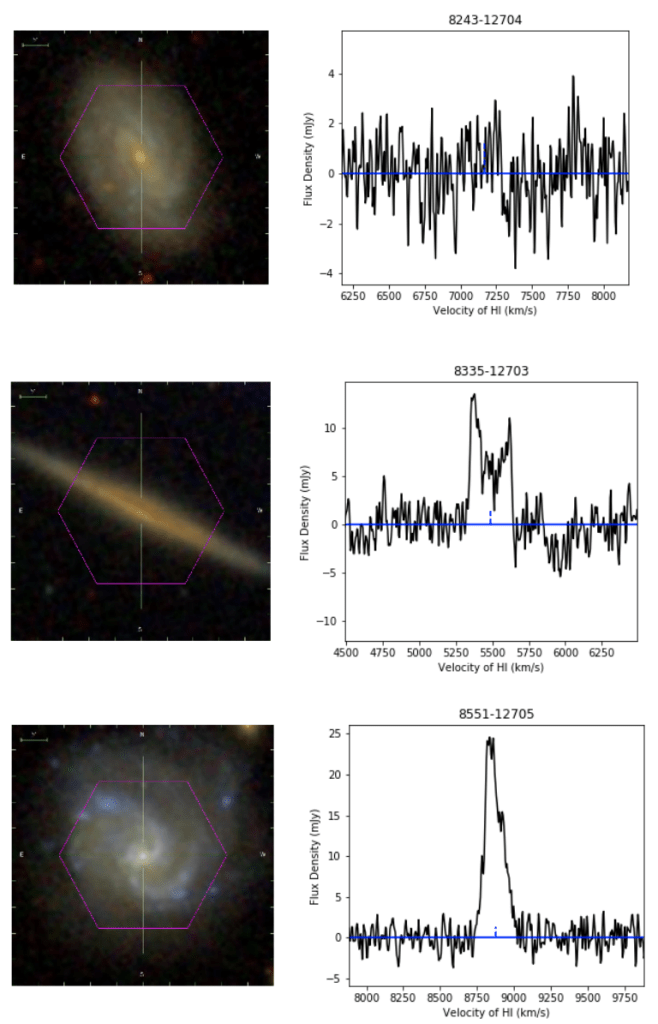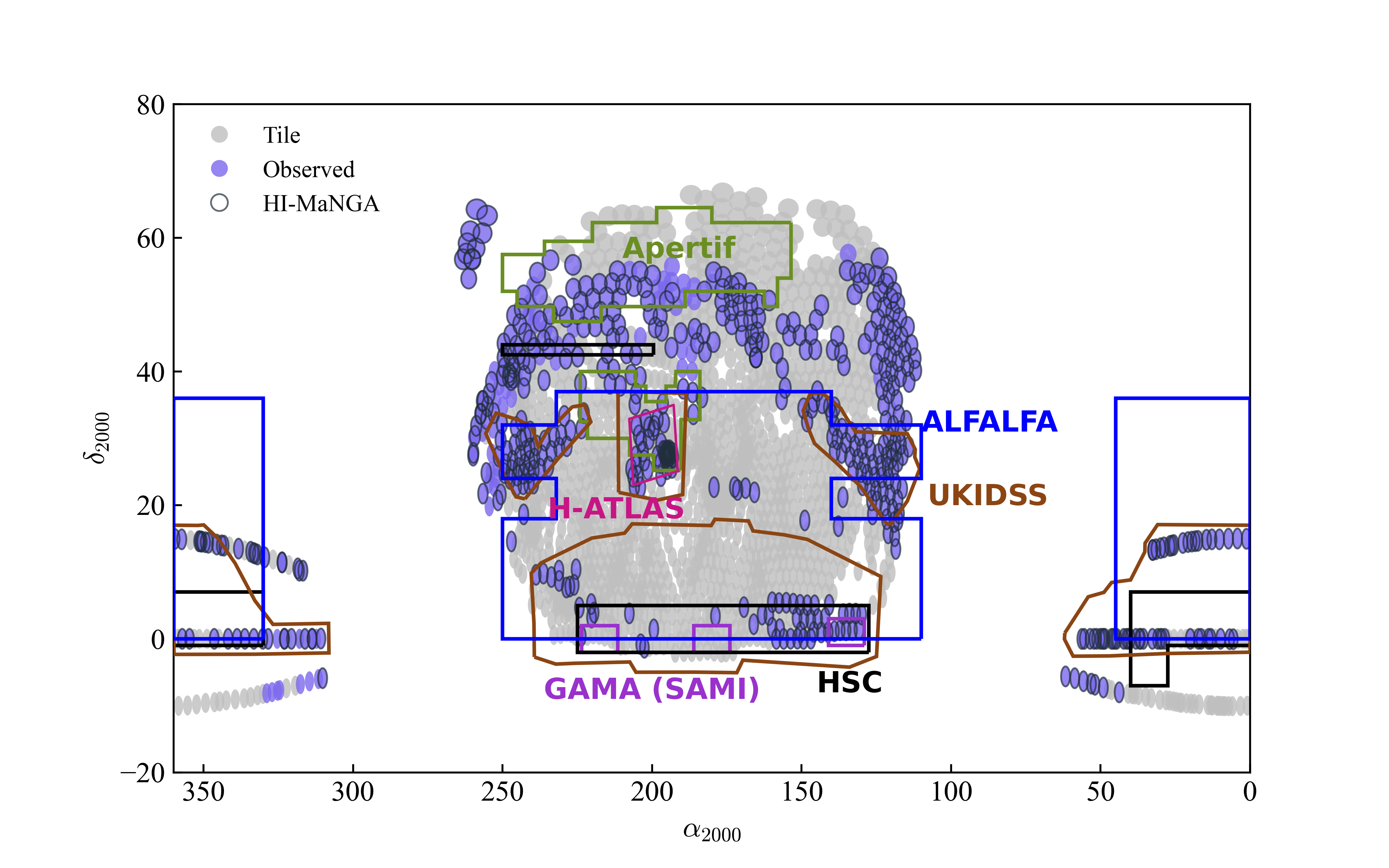HI-MaNGA
HI (21cm) Followup of MaNGA Survey Galaxies using the Green Bank Telescope.
Summary
The goal of HI-MaNGA is to provide valuable information about the cold gas content of galaxies, which can help to address several of MaNGA’s key science questions: (1) How does gas accretion drive the growth of galaxies? (2) What are the relative roles of stellar accretion, major mergers, and instabilities in forming galactic bulges and ellipticals? (3) What quenches star formation? What external forces affect star formation in groups and clusters? (4) How was angular momentum distributed among baryonic and non-baryonic components as the galaxy formed, and how do various mass components assemble and influence one another?
Observations have been ongoing at the Green Bank Telescope since 2016, with over 2000 hours of observing time under codes 16A-095, 17A-012, 19A-127, 20B-033, and 21B-130.
Available Data
- DR3 (released in SDSS-IV DR17)
- GBT observations of 3,358 galaxies
- ALFALFA (untargeted HI survey with Arecibo) crossmatch with 3,274 galaxies (including upper limits, and 274 galaxies with data from both ALFALFA and GBT)
- Catalog description can be found Stark et al. (2021)
- DR2 (released in Spring 2021)
- GBT observations of 2108 galaxies
- ALFALFA (untargeted HI survey with Arecibo) crossmatch with 1710 galaxies
- Catalog description can be found Stark et al. (2021)
- DR1 (released in SDSS-IV DR15)
- GBT observations of 331 galaxies
- Data can be found in an SDSS-IV DR15 VAC.
- Data descriptions in Masters et al. (2019)
Due to programming issue, the HI spectra of 15 ALFALFA detections which are close to the edges of the ALFALFA footprint could not be extracted and are therefore not provided in HI-MaNGA DR2. These are plate-ifu=['8139-12702', '8139-12704', '8139-12705','8139-6101', '8438-12704', '8446-12701', '8554-12704', '8939-1902', '8943-12702', '8981-12705', '9049-3704', '9086-12701', '9192-6102', '9493-12702', '9866-6103']. This issue is corrected in DR3.
Data Access
- DR3 is being released as a SDSS-IV DR17 VAC
- DR2 reduced spectra available via SciServer
- From the SciServer home page, click Login to SciServer
- If you have not yet created a free SciServer account, click Create a new account and follow the registration instructions
- Enter your SciServer username and password and click Submit to go to your SciServer Dashboard
- Click Compute to open SciServer's Compute tool in a new window
- Click Create container and follow the instructions - be sure to check the box next to SDSS Associated Data to mount the data volume containing the the HI-MaNGA DR2 catalogs
- DR2 catalog available here via the HI-MaNGA Website at GBT
Publications
- Ji et al. (2021): “SDSS-IV MaNGA: the physical origin of off-galaxy Hα blobs in the local Universe” (arXiv)
- Stark et al. (2021) "HI-MaNGA: Tracing the physics of the neutral and ionized ISM with the second data release" (arXiv)
- Goddy et al. (2020) “L-band Calibration of the Green Bank Telescope from 2016─2019” (arXiv)
- Masters et al. (2019) “HI-MaNGA: H I follow-up for the MaNGA survey” (arXiv)
- Fraser-Mckelvie et al. (2020) “SDSS-IV MaNGA: The link between bars and the early cessation of star formation in spiral galaxies” (arXiv)
- Lin et al. (2020) “ALMaQUEST – IV. The ALMA-MaNGA QUEnching and STar formation (ALMaQUEST) Survey” (arXiv)
- Roberts-Borsani et al. (2020) “Outflows in star-forming galaxies: Stacking analyses of resolved winds and the relation to their hosts’ properties” (arXiv)
- Lin et al. (2020) “SDSS-IV MaNGA: the indispensable role of bars in enhancing the central star formation of low-z galaxies” (arXiv)
- Sun et al. (2019) “Environmental Influences on Star Formation in Low-mass Galaxies Observed by the SDSS-IV/MaNGA Survey” (ADS)
- Lin et al. (2017) “SDSS IV MaNGA: Discovery of an Hα Blob Associated with a Dry Galaxy Pair—Ejected Gas or a “Dark” Galaxy Candidate?” (arXiv)
- Lin et al. (2017) “SDSS-IV MaNGA-resolved Star Formation and Molecular Gas Properties of Green Valley Galaxies: A First Look with ALMA and MaNGA” (arXiv)
Team
Karen Masters (PI), David V. Stark, Vladimir Avila-Reese, Matthew Bershady, Nicholas Fraser Boardman, Brian Cherinka, Sean Dillon, Catherine E. Fielder, Daniel Finnegan, Patricia Fofie, James Garland, Julian Goddy, Emily Harrington, Roma Hladky, Rachel Langgin, Zach Pace, Frederika Phipps, Rogemar A. Riffel, Rogerio Riffel, Kate Rowlands, Wiphu Rujopakarn, Nattida Samanso, Jose R. Sanchez-Gallego, Shoaib Shamsi, Griffin Shapiro, Anubhav Sharma, Lucy Newnham, JT Turner, Jessica Washington, Elizabeth Warrick, Anne-Marie Weijmans, Catherine A. Witherspoon, Nathan Wolthuis, Zheng Zheng (Current or former undergraduate team members in bold)
c




